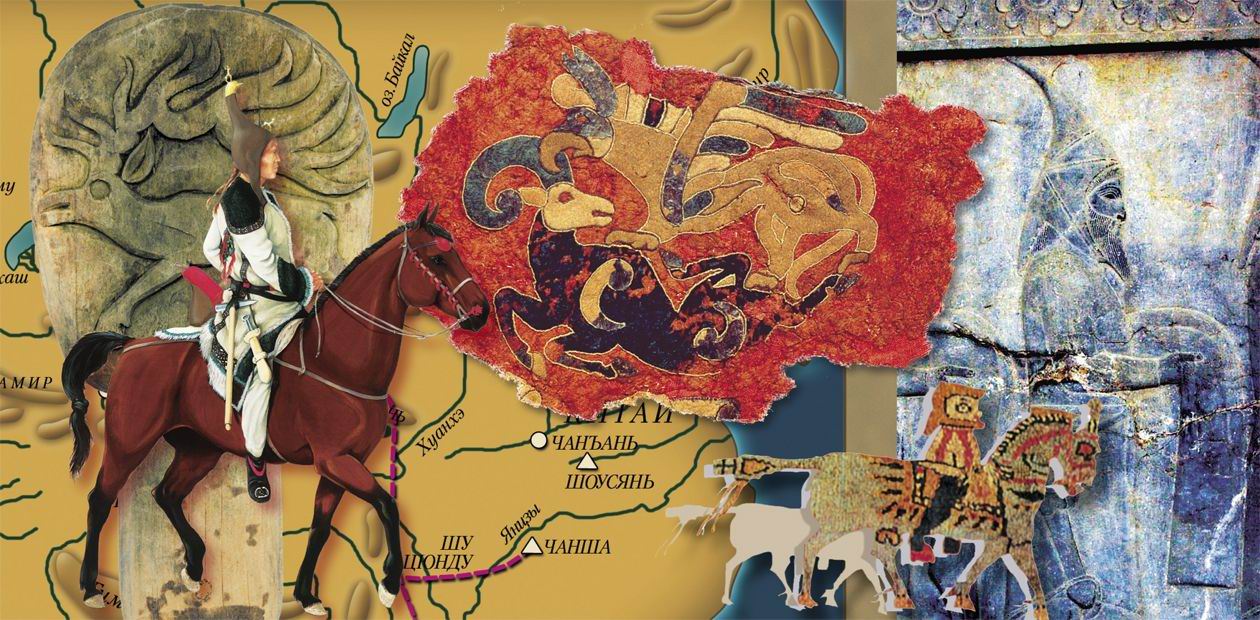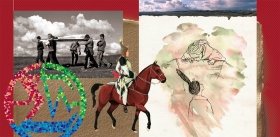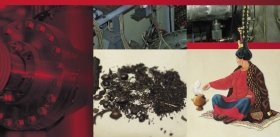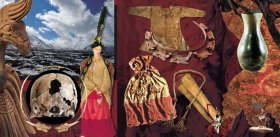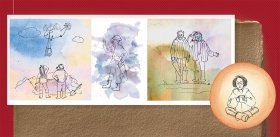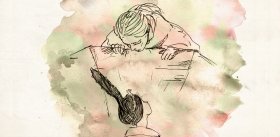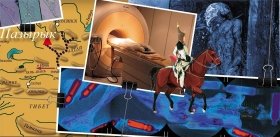Purple and Gold over Thousands of Years
The first burial mounds with “frozen” tombs were discovered by V. V. Radlov (Katanda burial mound and a burial mound at the Berel burial site of the Pazyryk culture, Kazakhstan) in 1865. He was the first to find clothes preserved in ice. One of the most remarkable of his finds — the so-called Katanda caftan — is now exhibited at the State Historical Museum (Moscow). The collection of this museum has another unique find from the Katanda burial, a “tailcoat” of sable fur covered with Chinese silk (this garment is called a “tailcoat” because it is made in this style)
Archaeologists deal mainly with imperishable objects, whereas the vast bulk of ancient material culture, made of organic materials, is lost without a trace. Among that which is lost forever are clothes, or the “second skin” of man. Therefore, when researchers miraculously find costumes which are intact, this is a truly remarkable discovery. This occurred with the “frozen” tombs in the Altai Mountains, which belonged to an ancient culture (the fourth to third centuries B. C.), which was given the name Pazyryk (according to the location of one of the most striking monuments — the burial mounds in the terrain of Pazyryk in the Ulagan Uplands, which were excavated in the 1930s and 1960s).
In most cases, archaeologists deal with fragments of artifacts, not with intact things. Therefore, they often have to reconstruct the entire costume using near traces of clothes and small pieces of decorations. However, one can verify the correctness of such reconstructions only when actual garments are found during archaeological excavationsExcavations of the Great Pazyryk Burial Mounds (Pazyryk, Bashadar, and Tuekt) conducted in the Altai Mountains in the 1960s yielded unique archaeological materials; however, clothes were not abundant. All these burial mounds were looted long ago: clothes were taken off the bodies, numerous artifacts were lost, and many of them were unidentifiable because of severe damage. Nevertheless, magnificent remnants of the costume of the Pazyryk cattle breeders, who lived in mountain valleys of the Altai, were thoroughly studied, and researchers gained some insight into the ancient costume (Rudenko, 1953, Yatsenko, 1999).
In 1990–1995, burial mounds filled with ice were found intact on the Ukok Plateau (Kosh-Agach District of the Altai Republic), for the first time in the history of studying the Pazyryk culture (i. e., in more than 130 years). The discovery of ancient mummified bodies wearing the clothes of the remote epoch was a sensation. The ten-year scientific investigation of the Pazyryk costume yielded amazing results, which turned out to be even more interesting than the discovered artifacts themselves.
A container of man’s soul: beyond the real world…
All traditional cultures have a special attitude to clothes, believing that the costume is a container of man’s soul. All clothes worn by man bear a part of his personality in this life as well as in the afterlife. This is one of the firmest beliefs that has partially survived to the present day in the form of some superstitions related to clothes. When studying the ancient costume, we deal with the things that bear the “souls” of their owners. Costumes preserve the spirit of the time and the color and flavor of extinct cultures, personifying those who passed away long ago. Studying the style of specific details, materials, colors, and dyestuffs of an ancient garment, we an can form a picture of a particular historical epoch with its technological achievements, knowledge and experience, geographical discoveries, natural resources, as well as cultural relationships, values, preferences, and prejudices. When studying costumes, we are trying to find out about man from the remote past.
Every culture has its own smell. The Pazyryk culture is flavored with a slight aroma of hemp, whose seeds were uncovered in the Great Pazyryk Burial Mounds. The seeds were found in a decorated leather flask and on smoked stones lying inside a bronze kettle. The Pazyrykians presumably had a habit of inhaling the fumes of burning hemp, which produced a light narcotic effect. The artifacts found in all the Great Pazyryk Burial Mounds suggest that the ceremony was carried on as Herodotus once described. He reported that the Scythians took hemp seeds and went into a felt yurt. Then, they placed the seeds onto red-hot stones. The steam and smoke from the seeds was so strong that no Hellenistic bath could compare with this Scythian “bath.” The enjoyment made the Scythians cry out very loudly (Herodotus, Book IV, 75). This habit was fatal for those who inhaled the fumes from burning hemp seeds over bronze kettles (such a kettle was found in the Second Pazyryk Burial Mound) because they were gradually poisoned by toxic evaporations containing copper compounds (Polosmak and Trunova, 2004). Another smell typical of the Pazyryk culture was coriander, whose seeds were used for their aroma. Coriander seeds were kept not only in bags; they were also found on a stone plate near the head of a deceased woman from Tomb 1 at the Ak-Alakha-3 cemetery.The fragrant aroma of coriander was meant to mask the odor of decay and was a gift to the deity to whom the deceased was sent. The felt pillow stuffed with an aromatic plant, which was found under the head of a man from Tomb 1 at the Verkh-Kaldzhin burial site suggests a great role of fragrant substances in the Pazyryk culture. There was another strong aroma, that of ziziphora, which accompanied the Pazyrykians on their way to the “Heavenly Pastures.”
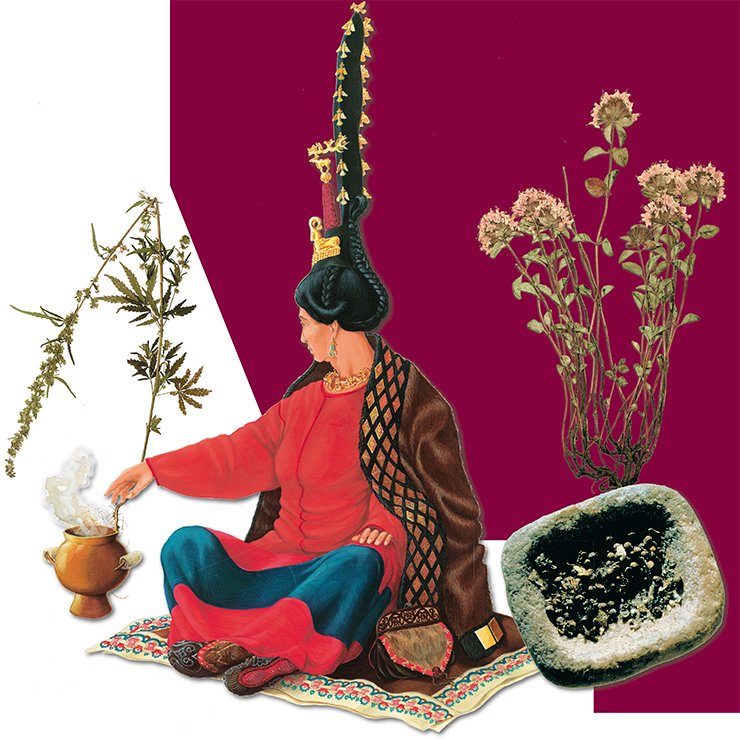
The Pazyryk burials on the Ukok Plateau contained intact garments that comprised a costume, just as if it were an ethnographic collection. However, unlike the case of ethnographical collections, the people who wore these costumes and who could have told us more about the textiles, disappeared long time ago.
More than two thousand years ago, a young man (20—25 years old) and a young woman (28—30 years old) of the Caucasoid type were buried on the Ukok Plateau probably in the same year (as determined by a dendrochronological analysis). Their bodies, clothes, accompanying burial goods, and horses were preserved in ice. These were two different burials located in different cemeteries, which belonged to the same culture: the woman was buried in Tomb 1 at Ak-Alakha-3 in the Ak-Alakha River valley; the man was buried in Tomb 3 at the Verkh-Kaldzhin burial site located on the right bank of the small river, Verkh-Kaldzhin, which gave the name to this burial site.
It is now evident that the male costume of the Pazyrykians was definitely a costume of horse riders. The garments from the Gornyi Altai burials are probably the earliest examples of the costume of horse riders ever found, which first of all included trousers, the most significant piece of the costume of Eurasian mounted warriors, riders and cattle breeders. Note that though trousers are known today as a usual garment, in those times, trousers were unacceptable in many “civilized” societies. Thus, unlike the Persians, neither Greeks nor the Romans wore trousers because it was unacceptable for them to wear these “barbarian” clothes.
Sima Qian, an ancient Chinese historian, in his Shi-Ji (Historical Records) described a famous dispute about trousers, such as those found on the man from Verkh-Kaldzhin-2, which occurred in ancient China in the 4th century B.C. Wuling Wang, the ruler of the State of Zhao, being anxious about the constant military threat from the neighbors and being eager to “open the way to the lands of the Hu and Di” 4, decided to introduce the tradition of wearing barbarian clothes, which fitted better the life of mounted warriors than the traditional Chinese costume. He thought that everything, including clothes, weapons, and tools should be convenient for use (Sima Qian, 1992, p. 65). However, the court was insulted by this innovation. Wuling Wang was accused of failing to follow the old doctrines, changing the path of ancestors, and acting against wishes of people, thus grieving scholarly men and neglecting ancient traditions (Ibid.). Wuling Wang argued that it would be impossible to achieve progress in the present day if one followed only ancient traditions and laws and did not keep up with changes and innovations. Sima Qian wrote that after Wuling Wang won the dispute, he dressed his subordinates in the Hu-style clothes… and fulfilled his plans.
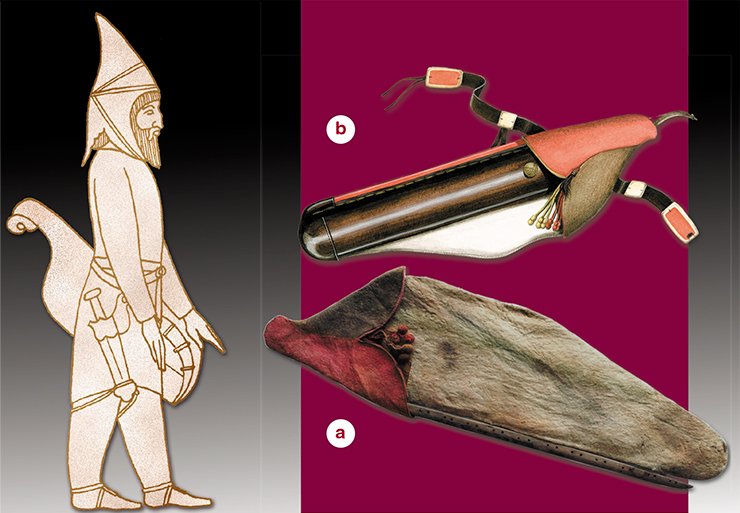
The costume of mounted warriors had expanded over vast territories and reached as far south as Indo-China, where it was recorded in the materials of the Dien culture (modern Szechwan and Yunnan) dated to the 700—300 B. C. The burial artifacts of these cultures contained a rider’s outfit which included a costume depicted in realistic bronze casting. The costume of horse riders overcame cultural and ethnic barriers and became a sign of affiliation with “people riding horses,” i. e., mounted warriors and horse breeders. The actual Pazyryk costume has much in common with all clothes of Eurasian nomads of the second half of the 1st millennium B. C. depicted on numerous pieces of ancient art. Nevertheless, the Pazyryk costume bears features pertinent only to this specific culture.
In contrast to what was expected, the Pazyryk warrior was wearing trousers made of coarse woolen twill rather than of leather. This fabric was woven of sheep’s wool mixed with camel wool. It was dyed red using madder, a dye obtained from madder roots. The style of the trousers is very simple: two legs connected with a square piece of cloth. The trousers have traces of intense use and mending (a patch and a darn). On the waist, they were belted with a plaited woolen cord. The legs became narrower towards the bottom, and extended well below the knees. They were tucked above the knees into high felt stocking-boots with soft soles, which expanded at the upper edge. The man had a short fur coat without a collar made of finely dressed sheep skin with the fur turned inside. The man was wearing the fur coat next to his skin. An interesting detail is a 57 x 49 cm “tail” made of sheep skin and attached to the back of the fur coat. The coat is decorated with stripes of carved leather, pieces of sable fur, tassels of horse hair of red color, and black colt’s skin. The coat has neither clasps nor ties, being wrapped across the chest and secured at the waist by leather belts fastened with wooden buckles. There were two belts: one was used to suspend a felt gorit (a sheath for the bow) and the second, main belt was used to carry a battle-axe and a dagger. This tradition is of Iranian origin, as indicated by the depictions of warriors on ersepolis bas-reliefs (Iran).
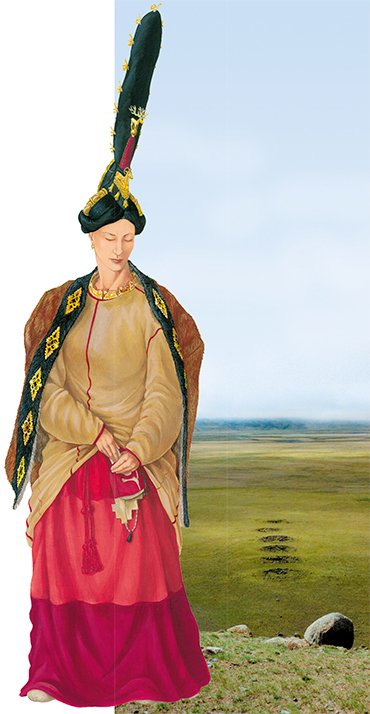 The fur coat has long sleeves whose edges could be tightened with a lace. In this manner, the sleeves could have been used as pockets or bags for keeping small things (in this case, the wearer could simply slip his fur coat on). Because neither gloves nor mittens of any kind were ever found in the Pazyryk tombs, we can assume that the long sleeves that covered the wrists served as “mittens” as well. The deceased man had his arms put in the sleeves. However, on a warm day, the fur coat was cast off the shoulders and held by a belt, uncovering the tattooed chest and arms. This manner of wearing upper garments (which were often worn without any underwear) was typical of Asian cattle breeders. The ethnographers and travelers of the 19th-20th centuries reported this manner of wearing upper garments among the Tibetans, Mongols, and Altai people.
The fur coat has long sleeves whose edges could be tightened with a lace. In this manner, the sleeves could have been used as pockets or bags for keeping small things (in this case, the wearer could simply slip his fur coat on). Because neither gloves nor mittens of any kind were ever found in the Pazyryk tombs, we can assume that the long sleeves that covered the wrists served as “mittens” as well. The deceased man had his arms put in the sleeves. However, on a warm day, the fur coat was cast off the shoulders and held by a belt, uncovering the tattooed chest and arms. This manner of wearing upper garments (which were often worn without any underwear) was typical of Asian cattle breeders. The ethnographers and travelers of the 19th-20th centuries reported this manner of wearing upper garments among the Tibetans, Mongols, and Altai people.
The man also was wearing a felt helmet with earflaps, which was sewn of two identical pieces tipped with a figurine of a bird’s head (the head looks like a pigeon’s head). The high tip of the helmet stands straight up owing to a special wooden framework inserted inside. The helmet is decorated with the figurines of fantasy creatures (deer and horses with horns of a wild goat) covered with gold foil. This is the first time that actual felt helmets described by Herodotus were ever found. He wrote that the Sakas wore high, sharp-tipped, thick hats standing straight up (Herodotus, Book VII, 64). We can see the depictions of such helmets on the Persepolian bas-reliefs and on numerous Scythian bronze art objects. Felt helmets of similar form were spread among different peoples that lived in different times and countries. However, the Pazyryk helmets differ from the known examples because they were richly decorated with fantasy creatures combining the features of deer, horse, and wild goat.
The man buried on the Ukok Plateau had light reddish hair cut in the front and forming long bangs on the forehead. On the top of his head, a large area of uncut hair was plaited into two braids, each comprised of two strands, which extended below the shoulders.
The man had a wooden neck decoration (either a personal amulet or a sign of his social status) covered with golden foil. The ends of the necklace were in the shape of snow leopard heads, his personal guardians and patrons.
Female rider: keeper of hearth and home
The female costume found in the Pazyryk tombs surpassed our expectations because it was actually the costume of a female rider.
The woman was wearing a long, wide woolen skirt sewn of three horizontally folded bands of material. The skirt length was 144 cm, its width at the top was 90 cm, and the width at the bottom was 112.5 cm. Each of the bands was dyed in different shades of red: the upper piece was scarlet, the middle band seemed not dyed, and the lower band was deep burgundy. As these colors were obtained by hand dyeing, it was quite difficult to gain the same color. The skirt was beautiful mainly because of the different colors of the bands. Moreover, both the color and number of the bands had a deep meaning and indicated the woman’s status and her affiliation with a certain community.
The skirt was belted with a plaited thick lace of woolen threads finished with tassels. Similar to the male trousers from Tomb 3 (Verkh-Kaldzhin-2), the lace was dyed using madder, which yielded a red-orange color. This lace was used to regulate the length of the skirt, which could be fastened both on the waist and below the breast. We note that in many cultures plaited belts were important symbols, not just a piece of clothes, which served as talismans as well as memorial tokens used to keep important information. For example, the ancient Chinese had a secret system of tying knots on braids (jesheng) known only to the initiates. This looked like a soft belt or a braid with two tassels, each of the tassels made of six strands; each braid could have up to five knots (Stratanovich, 1965). Similar knots on the female belt from the Pazyryk tomb were obviously used as a counter (to count necessary things) or as a rosary (to remember and not miss something important).
Pazyryk women also wore knee-long light shirts with long sleeves and a round neck trimmed with red lace. In the Pazyryk tombs, three shirts have been found so far (one of them in fragments). It is surprising that in those remote times, when there were no fashion magazines to spread ideas about the style and details of clothes, ancient people made their shirts in the same style: the decoration principles and the cut of the shirts found in the Altai Mountains were identical to those found at the sites in Xinjiang oases. The female shirts from the Pazyryk tombs were made of tussah silk (or wild silk) and cotton. These are the earliest examples of tussah silk of non-Chinese origin (the Chinese started producing silk fabrics from domesticated silk worms in the third millennium B. C.). This tussah silk was presumably manufactured in non-Chinese states (south of modern China) or in Assam (modern India) that had been culturally affiliated with south-east Asia since early times. Cotton fabrics from the Pazyryk tombs are quite coarse. They must have been manufactured in the above-mentioned regions (it is of interest that Indian weavers were famous for their fine muslins). These regions are natural habitats of the two species of silkworms that produce wild silk, tussah.
The upper female garments were richly decorated, light fur coats with long narrow sleeves and a tail on the back side. The fur coats were ornamented with leather appliqué and stripes of colored fur. The designs on clothes included animal images for protection and recognition purposes. Pazyryk women, as well as men, wore long (above the knee) stocking-boots of white felt decorated with appliqué made of felt.
The composition and structure of the female wig was a complete surprise. The woman shaved her head to wear the wig. The frame for the wig was a skin-tight felt hat with two layers of hair sewn on top. A special black pliant mass was applied between the layers of hair to form the shape and volume of the wig.
A group of researchers from the Boreskov Institute of Catalysis, SB RAS, headed by V. V. Malakhov (Doctor of Chemical Sciences) identified the composition of the viscous form-shaping material. The results threw light on the technique of its manufacturing as well as on some ideological and mythological ideas underlying this tradition. The composition of the form-shaping material is inhomogeneous. The material has a strong, unpleasant odor. The main components are coal-black particles 0.2–2.0 mm in size, which are highly carbonized fragments of grain husks, a finely dispersed soot-like black substance, and a plastic mass (gray from above and yellowish white inside)Analyses of the form-shaping material revealed the chemical composition of the filling substance and made it possible to reconstruct the technique of how this wig was made. The ductile components of the form-shaping material were acylglycerides (fats) and products of their decomposition, fatty acids and acrolein, a substance with a strong, specific odor. The absence of unsaturated fatty acids with conjugated double bonds or with a methylene group between the pairs of double bonds suggests that the fat used for the wig was of animal rather than vegetable nature. The form-shaping material also included some inorganic components, such as clay. Because of the excellent ductile characteristics of clay and fat, this mass was used as a form-shaping substance for the headdress.
It is highly probable that a strongly carbonized substance used as a filler of the form-shaping material was produced by pyrolysis of coarse grains in a sealed vessel on an open fire at a temperature of 450–455° С (842–1022 F). The carbonized mass was then cooled to the ambient temperature and used when necessary. To make the wig, the carbonized filler was mixed with heated fat to form a homogeneous viscous substance. This composition was then applied to the felt hat, which was put on a wooden form having the size of the head of the wearer, and the base of the wig was formed. Then the hair-do, set in a given shape, was held with the help of the hair itself, which formed kind of a case wrapped around the form-shaping material.
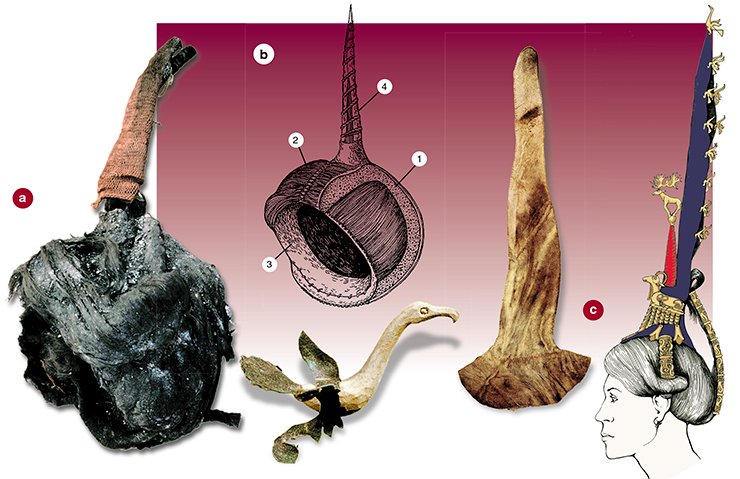
As mentioned above, one of the main components of the form-shaping material was fragments of carbonized grain husks. The fact that grains were used to construct a female wig seems to be full of symbolic meaning. Seeds and grains are obviously the deepest and the most common vegetative symbols embodying the idea of continuous life and fertility. Serving as containers for spirits, seeds and grains were often sacrificed to deities and used as talismans. Now we might only guess at whether the process of burning grains in a sealed vessel on a fire was meant to be a special bloodless sacrifice to gods or patron spirits. Then, this mass was used to create one of the most significant elements of costume, the headdress, which embodied the essence of protective and distinguishing functions of the costume. The fact that carbonized grains burnt in a vessel were added to the frame of the female coiffure testifies to the veneration of fire (hearth) and woman (hearth keeper) practiced by the Pazyrykians.
On the top of the head, a lock of the woman’s hair was wrapped in a piece of felt and tightly tied with a woolen lace. These manipulations allowed the bundle of hair to stand vertically. The bundle was put into a casing (nakosnik) plaited of red wool. A bronze hairpin decorated with a figurine of a deer standing on a sphere was stuck into the casing. As all Pazyryk wooden figurines, this deer was covered with golden foil. A long (about 68.5 cm) leaf-shaped wooden stick covered with felt and a piece of black cloth finished the wig. This stick was decorated with 15 wooden birds, diminishing in size, like Russian matryoshka dolls. The birds had leather wings, legs, tails, and long necks (maybe these birds were swans).
This leaf-shaped stick with numerous birds can be treated as a symbol of the World Tree or its numerous variants (Tree of Life, All-healing Tree). The idea of the World Tree was shared by different peoples and spread in many cultures all over the world. In full accordance with mythological beliefs, at the bottom of the Pazyryk World Tree of Life is a wooden figurine of a deer with the horns of a wild goat, whose image is present on male headdresses as well. In some cases, women used felt casings to cover their complex coiffures, decorated with long hairpins and numerous wooden figurines (covered with golden foil) of birds and animals. Personal decorations of the deceased woman were plain earrings of gold, a wooden necklace covered with golden foil and decorated with the figurines of winged snow leopards. On the waist there was a felt bag with a mirror inside. The mirror was a bronze plate in a wooden frame decorated with a carved deer. The bag also contained a few Indian glass beads, several paste beads, and a blue powder scattered near a tassel of horse hair, which was suspended from a thread of cylindrical stone beads. It was identified that the blue powder was vivianite, a mineral used now to produce a cheap blue paint. The Pazyrykian woman obviously used this blue powder as a cosmetic preparation.
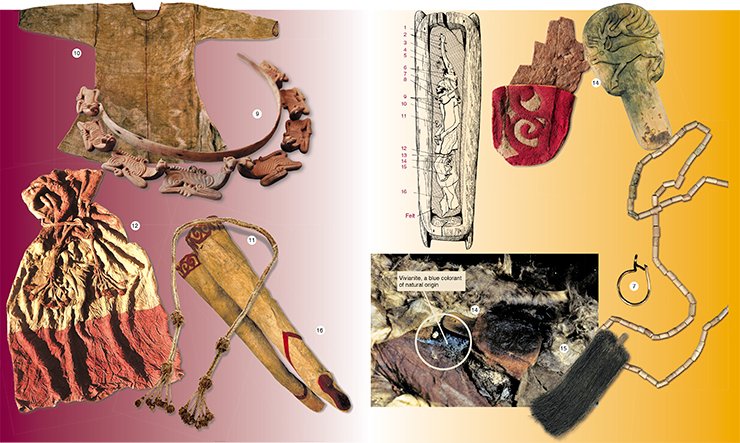
In ancient times, cosmetics were in wide use among both women and men. The Medians outlined the eyelids and reddened the cheeks (Xenophon, Book I, Chapter III, 2). As Strabo said, the Indians did everything that could make their faces look better (Book XV, Chapter I, 30, 54). A highly developed production of cosmetic preparations existed in ancient Egypt. However, people painted their faces not only for cosmetic purposes. In most cases, makeup had a magical or sacral meaning and was devoted to important events in a person’s life or identified his or her social status. Moreover, women in Central Asia used to apply fat-based ointments (generally, red or black in color) to their faces to protect the skin from wind, sun, and cold weather.
Between light and darkness
There are numerous references about ancient and medieval peoples who made permanent marks on their bodies. However, the bodies of the Pazyrykians provide us the only known material evidence of the earliest tattooing practics. The tattoos on the bodies of the Pazyrykians indicate the high level of proficiency of tattooists: the mummies from the “Great Burial Mounds” are covered with tattoos from head to foot. The man from an ordinary tomb under Burial Mound 3 at Verkh-Kaldzhin-2 had only one tattooed image on his body, but its quality, artistic composition, and the design itself (an image of a fantasy deer-griffin-wild goat) is comparable to the tattoos on noble mummies).
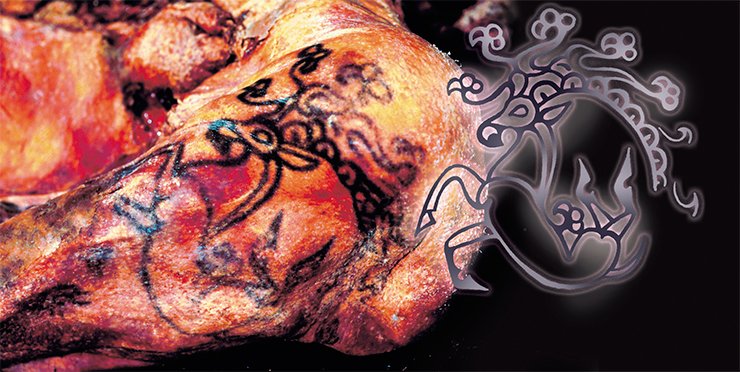
They say that clothes are the second skin of man, and tattoos have a closer relation to skin than clothes. Tattooed skin is a sacral envelop of a person; it is thought to make the person protected, invulnerable, and significant. For example, the ancient Indo-Iranians identified the skin with the Abyss located on the way to the Otherworld, a door between the polar worlds, between the known and unknown, between light and darkness, between life and death (Makovsky, 1996). Tattoos played an extremely important role in people’s lives: they distinguished man from the animal world, identified man’s membership in a group, and provided a connection for a person with his ancestors and descendants who were supposed to recognize him by these signs. Now we can only guess at what exactly the tattooed images depicted: either cosmogonic myths and mythical heroes, animal-protectors, or marks of social rank and status. Obviously, we will never find an answer to this question. However, the animal species and artistic style of the tattooed images can tell us more about who these people were and where they came from. The Pazyryk tattoos depict fantasy creatures typical of this culture, such as deer-griffin-wild goat and mythical felines with bird-like beaks, as well as real animals that inhabited the Altai Mountains (tigers, argalis, or wild sheep, and wild goats) and those that never lived in this area (Asiatic wild ass). Another popular image is a spotted cat that can be either an Altai snow leopard or a leopard which never lived in the Altai Mountains (the latter is possible because artifacts of such leopard skin were found in the First and Second Pazyryk Burial Mounds).
Thus, the tattoos show that the people buried in the Altai “frozen tombs” were representatives of a large cultural community extending far beyond the Altai Mountain region.
Skilful weavers and dyers
Fabrics played a surprisingly important role in the life of the Pazyrykians. Pazyryk dresses were made mainly of woven fabrics. However, for people who lived in the mountain valleys surrounded by the taiga, clothes of woven fabric seem to be inconvenient: such clothes are easily torn and worn out. Almost all garments found in the Pazyryk tombs were mended many times: one can see numerous patches and darns. In addition, felt, woven fabrics and woolen laces were used to decorate horses; the Pazyryk burial chambers were decorated with felt carpets having appliqueé designs.
Dyes in the Pazyryk fabrics were identified at the Novosibirsk Institute of Organic Chemistry within an integrated project funded by the Siberian Branch of the Russian Academy of Sciences. The methods used included molecular spectroscopy and liquid chromatography. Three-year studies carried out by G. Balakina, E. Karpova, and V. Vasiliev under the leadership of V. Mamatyuk produced unexpected results: the textiles from the Pazyryk were colored using the best dyestuffs of animal and vegetable origin of that epoch, which had no connection with the Altai Mountains or with their environsPeople living in the Altai Mountains at various times never had a highly developed weaving industry for manufacturing fabrics of the quality comparable to those from the Pazyryk graves. Most of the materials they used were imported from other regions. So, the Pazyrykians did not produce the woolen fabrics they wore. They brought these fabrics together with many other things they used in their everyday life. Although we cannot locate the exact production center of these fabrics, we can outline the region from where the remarkable clothes recovered from the Pazyryk burials could have originated. The dyestuffs used to color the Pazyryk fabrics are important in outlining the region of production. It was established that the materials were dyed using a combination of three colorants. This indicates that all the three dyes were readily available in a place where these fabrics were colored. This can be the eastern Mediterranean, which is the only natural habitat of a small insect — К. vermilio, the source of the kermes acid, which was used to dye the Pazyryk fabrics. The eastern Mediterranean adjoins on the east with the Armenian Highland, which is a habitat of another insect of the species Porphyrophora hamelii Brandt, Ararat cochineal insect (Yashchenko and Ambartsumyan, 1999). The third colorant, madder, was of vegetable origin. It was obtained from the roots of two madder species: Rubia tinctorum L., which grows in Iran and in the Mediterranean, and Rubia cordifolio L. widespread in China and India. The Pazyryk fabrics were dyed using the dyestuff from Rubia tinctorum L.
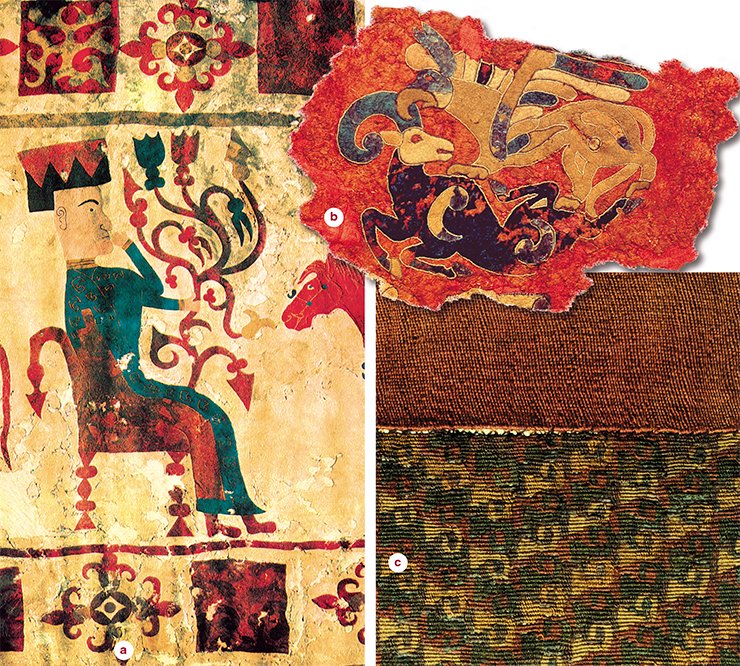
A combination of the dyestuffs identified in archaeological fabrics indicates not only the skillfulness of ancient dyers but also their developed sense of color because they managed to gain several shades of red and to imitate the famous purple color using a combination of two dyestuffs: red and blue. Since deep antiquity, long before the Pazyryk culture appeared, the raw wool for weaving fabrics was collected in one place, whereas the yarn, fabrics themselves and their dyeing took place in other regions, often quite remote from the source of the wool. Thus, in the second century B. C., the caravans of Ashur merchants were loaded with fabrics from Mesopotamia, which were produced from wool collected everywhere over Asia Minor, in the Ashur, in the valleys of the Tigris and Euphrates Rivers, and in other places. They transported rolls of fabrics and clothes that cost from 8 g to 6 kg of silver per item (Dyakonov, Yankovskaya, and Ardzinba, 1988). The fabrics were dyed in Phoenicia with a purple dye extracted from the Mediterranean sea snails or using plant and mineral dyes available in the Armenian Highland. The three colorants identified in the Pazyryk fabrics produced red color. Though ancient dyers could use any of the identified dyestuffs to gain red color, they always used a combination of the three dyestuffs in different proportions. This stable combination of three red dyes suggests that the dyers might have tried to achieve particular shades of red and, unlike us, probably saw the difference between these shades. For example, Xenophon wrote that Cyrus, the Persian king, distributed the best clothes to the most noble people and ordered to bring in other Median clothes, which were prepared by him in large quantities; he did not spare “purple cloaks, dark-red, crimson, or scarlet ones” (Cyropaedia, VIII, III, 3). Cyrus, himself, wore a purple tunic with a white stripe in the middle and long, tight trousers (anaksirid) of red color and a purple candiy (Cyropaedia, VIII, III, 13). This reference shows that in addition to purple, the Persians distinguished at least four more shades of red color and had a perfect perception of the red color spectrum. This phenomenon probably is rooted in the Indo-Iranian history of the Persians. A study of the color code in the Rigveda revealed that the Arian deities were characterized, as a rule, with different colors belonging to the light, bright part of the spectrum. The color characteristics of the Surya, Savitara, Usas, and Agni solar deities show that people distinguished perfectly different shades of red, purple, yellow-red, golden, and pink (Elizarenkova, 1999, p. 484).
The Qualitative Composition Of Dyestuffs Identified In The Pazyryk Textiles Was Determined Using Two Methods: High-Speed Liquid Chromatography (“Agilent 1100 Series Lc/Msd” Liquid Chromatograph/Mass Selective Detector) And Molecular Spectroscopy Hp 8453 Spectrometer).The most difficult task in the determination of dyes in ancient fabrics is extraction of a dye into a solution because the quantity of the analyzed samples does not exceed several milligrams. It is also necessary to use standards for individual dyes. For a chromatographic analysis, a sample of ancient fabric was treated with a methanol solution of hydrochloric acid during boiling. This “severe” treatment was required to liberate the dye in a soluble form by destroying the dye—mordant cation—fiber complexes. Identification of the qualitative and quantitative composition of the dyes was performed by chromatography of 0.3 ml of the solution (after the remaining wool fibers were separated).
Solutions obtained by treating textiles with an aqueous solution of aluminum sulfate which can liberate dyestuffs from fabrics were studied Lusing molecular spectroscopy. The second derivatives of the electronic absorption spectra of such solutions yield data on the composition of mordant dyes.
These two methods verify and supplement each other, which makes the information obtained more reliable.
And tutankhamen’s tunic...
Comparing the style of the Pazyryk garments with the clothes from the sites dated to earlier periods brings us again to the eastern Mediterranean countries. This region has always connected Egypt, the Asia Minor, Mesopotamia, and the states of the Aegean Sea basin. Wall paintings in Egyptian tombs show that long shirts with round necks, long sleeves and trimmed seams were in wide use among the peoples of Syria (Bogoslovskaya, 1995). Among actual archaeological finds, Tutankhamen’s tunics are similar, to a certain extent, to Pazyryk garments as these tunics turned out to be very wide in comparison with their depictions. The fragments of Parthian shirts from Palmyra (Syria) dated to later periods are also similar to the Pazyryk shirts. The Persian costume included similar long red trousers (anaksarid) and shirts (kandis), which we can see on the Pazyryk mounted warriors. The closest analogues to the Pazyryk costume can be seen on Persepolis bas-reliefs depicting the Sakas wearing highly peaked headdresses.
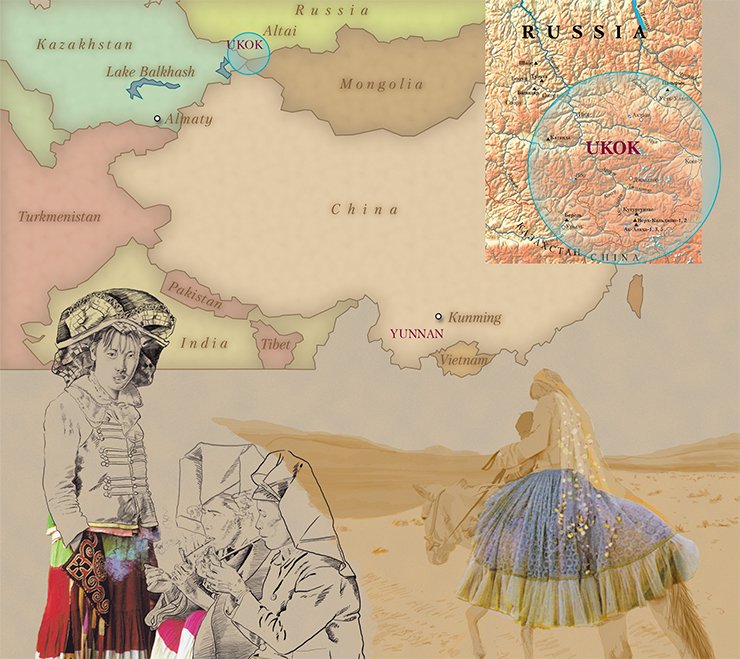
The Pazyryk female costume has fewer analogues among ancient clothes than the male costume. The women on Crete (first half of the second millennium B. C.) wore long, wide skirts, sometimes made of multiple horizontal frills, as depicted on the female figurines found in the Palace of Knossos and on the clay figurines of female deities from Mycenaean sanctuaries (Sidorova, 1972). It is believed that the Sumerians wore skirts made up of several horizontal bands of fabrics, and the upper band was rolled and served as a belt (Emelyanov, 2001).
In Iran and Afghanistan, women of numerous nomadic tribes that still practice their traditional lifestyle wear long wide skirts convenient for horse riding.
However, the strongest similarity is noted between the female Pazyryk costume and female clothes from the archaeological sites in Xinjiang oases, which are either synchronous to or younger than the Pazyryk culture (Subeshi, Karia, Shanpula, etc.).
Further history of the Pazyryk costume, which is almost identical to the costume of the population of Xinjiang oases, is connected with South-East Asia. Here, women of the yiju minorities (or yi) living in the south of China, whose history roots into deep antiquity, still wear long wide woolen skirts similar to the Pazyryk ones (Its, 1965).
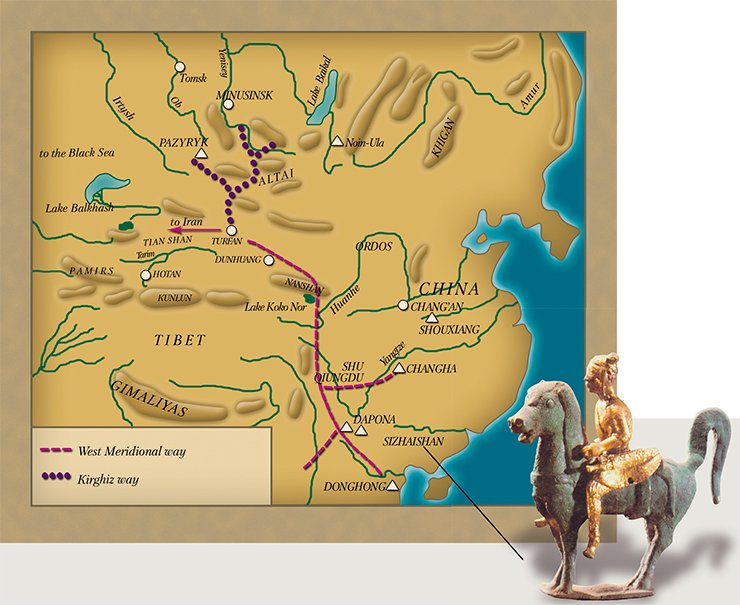
Having had to live in isolation in the Lianshan Mountains (modern Szechwan and Yunnan provinces) for many centuries, these people have preserved the ancient culture and traditions of their ancestors, including the above-mentioned horse riders of the Dien culture. The Yiju people speak a language of the Tibeto-Burman group of the Sino-Tibetan language family. Chinese sources report that in the second half of the 1st millennium B. C. the ancestors of the Tibetan peoples, the Qian, migrated to the south by the so-called Western Meridian Route, which connected southern Siberia, Inner Asia, and the northwestern regions of China with southwestern China, Vietnam, and Burma. The ancient Chinese called this route the “way of the qian.” In 400–300 B. C., a minor group of the Yuezhi (the so-called minor Yuezhi) who was forced by the Xiongnu to move southward used this route to migrate to the south. The majority of the Yuezhi (major Yuezhi) migrated to Bactria (Lubo-Lesnichenko, 1994). Thus, with this flow, together with other Inner Asian tribes from the Taklamakan Desert, the culture of the Pazyryks reached the south of Asia, where it was preserved in the clothes of the local population.
References
Bogoslovskaya I. V. Odezhda narodov biblejskih stran [Clothes of Peoples of Biblical Countries]. St. Petersburg, 1995.
D’yakonov I. M., Yankovskaya N. B., Ardzinba V. G. Severnaya periferiya Nizhnemesopotamskoy civilizacii IV–II tysjacheletiy do n. e. [Northern Periphery of the Lower Mesopotamian Civilization in the Fourth-Second Millennia B. C.] // Istoriya Drevnego Vostoka. Zarozhdenie drevneyshikh klassovykh obshchestv i pervye ochagi rabovladel’cheskoy civilizacii. Part 2. Moscow, 1988,p. 21—117.
Emel’yanov V. V. Drevniy Shumer. Ocherki kul’tury [Ancient Sumer: Cultural Studies]. St. Petersburg, 2001.
Lubo-Lesnichenko E. I. Kitaj na shelkovom puti [China on the Great Silk Road]. Moscow, 1994.
Polosmak N. V. and Trunova V. A. Volosy iz pazyrykskikh mogil (rentgenofluorescentnyi analiz s ispol’zovaniem sinhrotronnogo izlucheniya) [Hair from Pazyryk Tombs: An X-ray Fluorescent Analysis with Synchrotron Radiation] // Archaeology, Ethnography, and Anthropology of Eurasia. 2004, No. 1, p. 73—78.
Rudenko S. I. Kul’tura naseleniya Gornogo Altaya v skifskoe vremya [Cultures of the Gorny Altai in the Scythian Period]. Moscow—Leningrad, 1954.
Stratanovich G. G. Razvitie kitayskoj pis’mennosti [Development of the Chinese Written Language] // Narody Vostochnoy Azii. Moscow—Leningrad: Nauka, 1965, p. 346—349.
Yatsenko S. A. Kostyum plemen pazyrykskoy kul’tury Gornogo Altaja kak istoricheskij istochnik [The Costume of the Pazyryk Culture of the Gorny Altai as a Historical Source] // Vestnik Drevney Istorii. 1999, No. 3, p.145—169.


